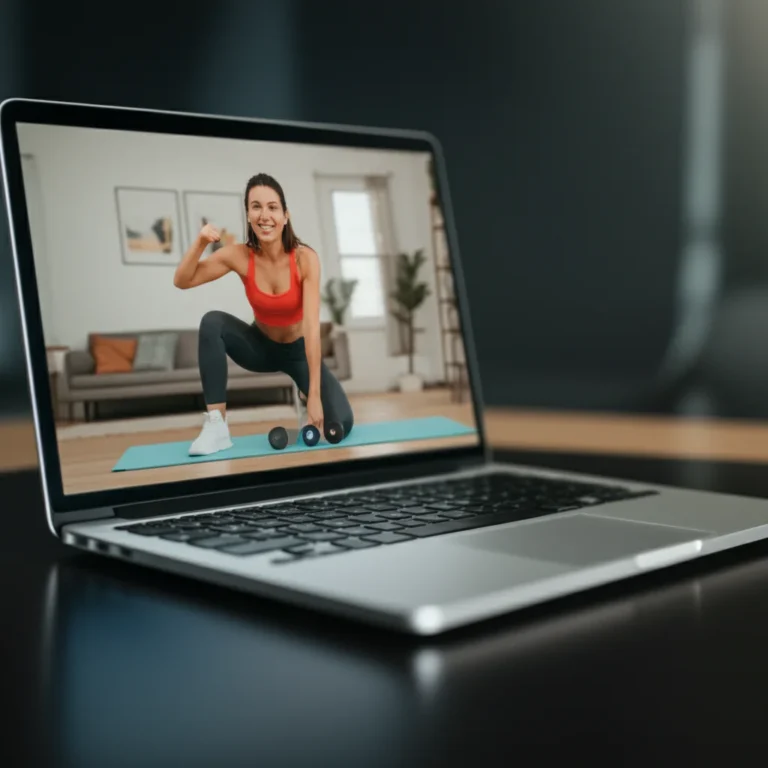Support our educational content for free when you purchase through links on our site. Learn more
How to Find the Best Virtual Personal Trainer for Your Fitness Goals 💪
In a world where convenience reigns supreme, the quest for the best virtual personal trainer has never been more relevant. With countless options at your fingertips, how do you sift through the noise to find the perfect match for your fitness journey? Did you know that nearly 80% of people who hire a personal trainer achieve their fitness goals more effectively than those who go it alone? This article will guide you through the essential steps to identify the ideal trainer tailored to your unique needs, ensuring you stay motivated and on track.
From understanding your fitness goals to evaluating trainers’ qualifications, we’ll cover everything you need to know. Plus, we’ll share tips on assessing technology and communication skills, which are crucial in a virtual setting. So, are you ready to embark on a transformative fitness journey? Let’s dive in!
Key Takeaways
- Identify Your Fitness Goals: Knowing what you want to achieve is crucial for selecting the right trainer.
- Look for Certifications: Ensure your trainer is certified by reputable organizations like ACE or NASM.
- Evaluate Communication Skills: Choose a trainer who is responsive and provides regular feedback.
- Consider Personality Fit: A trainer’s style should resonate with you to keep you motivated.
- Assess Technology Use: Ensure they utilize reliable platforms for training sessions.
Ready to kickstart your fitness journey? 👉 Shop for certified virtual personal trainers on ACE Fitness | NASM | Fitness Together!
Table of Contents
Quick Tips and Facts
Understanding Virtual Personal Training
How to Identify Your Fitness Goals
What to Look for in a Virtual Personal Trainer
Certified Online Personal Trainer: Why It Matters
Exploring NASM’s Certified Nutrition Coach (CNC)
The Importance of a Pain Management Specialist
NCSF Strength Coaching Specialist: What You Need to Know
How to Evaluate Online Training Programs
Finding the Right Fit: Personality and Training Style
Assessing Technology and Communication Skills
Business and Sales: The Guide to Success as a Personal Trainer
CEU Updates in Your Inbox
Subscribe to Our Blog for More Tips
Read More from the Fitness Category
Become a Personal Trainer: Your Path to Success
Virtual Training Certification: What You Should Know
Get FREE CEUs: Enhance Your Skills
Connect with Us for More Resources
Conclusion
Recommended Links
FAQ
Reference Links
Quick Tips and Facts
✅ Virtual personal training offers flexibility and convenience, allowing you to work out on your own schedule and in the comfort of your own home. (source)
✅ Look for certified trainers with experience in your specific fitness goals, whether it’s weight loss, muscle gain, or improved athletic performance.
✅ Communication is key in virtual training. Choose a trainer who offers regular check-ins, feedback, and support.
✅ Don’t be afraid to shop around and try different trainers until you find one who is a good fit for your personality and training style.
✅ Virtual personal training can be just as effective as in-person training when done correctly. (source)
Understanding Virtual Personal Training
Gone are the days when you had to drag yourself to a crowded gym and train under the watchful eyes of strangers. Virtual personal training has revolutionized the fitness industry, offering a flexible, convenient, and affordable way to achieve your fitness goals. But what exactly is it?
Virtual personal training involves working with a certified personal trainer remotely, using technology like video conferencing, fitness apps, and wearable trackers. This means you can train with a qualified professional from anywhere in the world, on your own time, and in the comfort of your own home.
Benefits of Virtual Personal Training
- Flexibility and Convenience: Train whenever and wherever it suits you, eliminating the need to commute to a gym.
- Cost-Effective: Virtual training often comes at a lower cost compared to traditional in-person training.
- Personalized Attention: Receive customized workout plans and nutritional guidance tailored to your specific goals and needs.
- Accountability and Motivation: Regular check-ins and communication with your trainer help you stay motivated and on track.
- Access to a Wider Pool of Trainers: Choose from a diverse range of certified professionals, regardless of your location.
Drawbacks of Virtual Personal Training
- Technology Dependence: Requires a stable internet connection and familiarity with technology.
- Limited Hands-On Adjustments: Trainers can’t physically correct your form in real-time, although they can provide visual guidance.
- Potential for Distractions: Working out at home may present distractions that could hinder your focus.
- Requires Self-Discipline: Staying committed and motivated without in-person supervision can be challenging for some.
How to Identify Your Fitness Goals
Before you embark on your virtual fitness journey, it’s crucial to identify your fitness goals. Are you looking to shed those extra pounds, build lean muscle mass, improve your cardiovascular health, or train for a specific event?
Having clear goals will help you:
- Choose the Right Trainer: Look for trainers with experience in your desired area of focus.
- Find the Right Program: Select a program that aligns with your goals and preferences.
- Stay Motivated: Knowing what you want to achieve will keep you driven throughout your fitness journey.
What to Look for in a Virtual Personal Trainer
Finding the right virtual personal trainer is crucial to your success. Here are some key factors to consider:
- Certifications and Experience: Look for trainers certified by reputable organizations like ACE, NASM, or ISSA. Experience in your specific fitness goals is a bonus.
- Personalized Approach: Choose a trainer who takes the time to understand your individual needs, goals, and preferences.
- Communication and Availability: Ensure your trainer is responsive to your messages, provides regular feedback, and is available for check-ins.
- Technology and Platform: Assess the technology used for training sessions, whether it’s video conferencing, fitness apps, or wearable trackers.
- Personality and Training Style: Find a trainer whose personality and training style mesh well with yours, creating a positive and motivating experience.
Certified Online Personal Trainer: Why It Matters
In the digital age, the role of a personal trainer has evolved. A Certified Online Personal Trainer brings the expertise and guidance of a traditional trainer to the virtual realm. But why is this certification so important?
A Certified Online Personal Trainer possesses the knowledge and skills to:
- Design Effective Workout Programs: Create customized plans tailored to your goals, fitness level, and available equipment.
- Provide Nutritional Guidance: Offer evidence-based advice on nutrition to support your fitness journey.
- Deliver Virtual Training Sessions: Conduct engaging and effective workouts through video conferencing platforms.
- Track Progress and Provide Feedback: Monitor your progress, provide feedback, and make adjustments to your program as needed.
- Motivate and Support Clients: Offer encouragement, accountability, and support throughout your fitness journey.
Exploring NASM’s Certified Nutrition Coach (CNC)
Beyond fitness expertise, many virtual personal trainers also hold certifications in nutrition coaching. NASM’s Certified Nutrition Coach (CNC) is a highly regarded credential that equips trainers with the knowledge to:
- Understand the Science of Nutrition: Gain a deep understanding of macronutrients, micronutrients, and their role in health and performance.
- Assess Dietary Habits: Evaluate clients’ dietary intake and identify areas for improvement.
- Develop Personalized Nutrition Plans: Create tailored nutrition plans based on individual needs, goals, and preferences.
- Promote Behavioral Change: Employ effective strategies to help clients adopt healthier eating habits.
- Provide Evidence-Based Guidance: Offer nutrition advice grounded in scientific research and best practices.
The Importance of a Pain Management Specialist
For individuals with pre-existing injuries or chronic pain, working with a trainer who specializes in pain management is essential. A Pain Management Specialist can:
- Conduct Thorough Assessments: Identify movement limitations, postural imbalances, and potential pain triggers.
- Design Corrective Exercise Programs: Create customized exercise plans to address underlying muscular imbalances and improve joint stability.
- Provide Pain Relief Strategies: Offer techniques and modalities to alleviate pain and promote healing.
- Educate on Injury Prevention: Teach proper movement patterns and exercise techniques to minimize the risk of future injuries.
- Collaborate with Healthcare Professionals: Work in conjunction with physical therapists, chiropractors, or other healthcare providers to ensure a holistic approach to pain management.
NCSF Strength Coaching Specialist: What You Need to Know
For those seeking to enhance athletic performance, an NCSF Strength Coaching Specialist can provide specialized guidance. These certified professionals are equipped to:
- Design Advanced Strength and Conditioning Programs: Create periodized training plans to optimize strength, power, speed, and agility.
- Implement Sport-Specific Training: Tailor programs to the specific demands of different sports and athletic activities.
- Conduct Performance Assessments: Evaluate athletic abilities and identify areas for improvement.
- Provide Nutritional Guidance for Athletes: Offer specialized nutrition advice to support training adaptations and recovery.
- Reduce the Risk of Sports-Related Injuries: Implement strategies to prevent common sports injuries and promote long-term athletic development.
How to Evaluate Online Training Programs
With countless online training programs available, it’s essential to choose one that aligns with your goals, preferences, and fitness level. Here’s what to consider:
- Program Structure and Content: Assess the workout frequency, duration, intensity, and variety of exercises offered.
- Trainer Expertise and Credentials: Look for programs designed and led by certified and experienced fitness professionals.
- Personalization and Customization: Determine the level of customization available, such as modifications for injuries or specific equipment needs.
- Community and Support: Explore whether the program offers a supportive community forum or access to coaches for guidance.
- Cost and Value: Consider the program’s cost in relation to its features, content, and level of support provided.
Finding the Right Fit: Personality and Training Style
Just like with in-person training, finding a virtual trainer whose personality and training style resonate with you is crucial for a positive and motivating experience.
- Motivational Style: Do you prefer a trainer who is tough-loving, encouraging, or a combination of both?
- Communication Approach: Are you comfortable with direct feedback or prefer a more gentle approach?
- Workout Preferences: Do you enjoy high-intensity interval training (HIIT), strength training, yoga, or a blend of different styles?
Assessing Technology and Communication Skills
Effective communication and reliable technology are paramount in virtual personal training.
- Video Conferencing Platform: Ensure the trainer uses a platform you’re familiar with and that offers high-quality video and audio.
- Fitness Tracking Tools: Inquire about the use of fitness trackers, apps, or other tools to monitor progress and provide feedback.
- Communication Frequency and Responsiveness: Discuss the trainer’s availability for check-ins, feedback, and answering questions.
Business and Sales: The Guide to Success as a Personal Trainer
For aspiring or seasoned personal trainers, understanding the business side of the fitness industry is crucial for building a successful career.
- Marketing and Client Acquisition: Learn effective strategies to attract and retain clients in a competitive market.
- Pricing and Packages: Develop competitive pricing models and create attractive training packages to meet client needs.
- Branding and Online Presence: Establish a strong brand identity and build a professional online presence to reach a wider audience.
- Client Management and Retention: Implement systems for effective client communication, scheduling, and program tracking.
- Continuing Education and Professional Development: Stay updated on the latest fitness trends, research, and business practices.
CEU Updates in Your Inbox
Stay ahead of the curve in the ever-evolving fitness industry by subscribing to our newsletter for the latest CEU updates, industry news, and valuable fitness tips.
Subscribe to Our Blog for More Tips
Don’t miss out on our latest blog posts packed with informative and engaging content on all things fitness, nutrition, and wellness. Subscribe today!
Read More from the Fitness Category
Explore our extensive library of articles in the Fitness category to deepen your knowledge and discover valuable insights.
Become a Personal Trainer: Your Path to Success
Are you passionate about fitness and eager to help others achieve their health and wellness goals? Learn more about how to become a certified personal trainer and embark on a rewarding career path. Learn more about becoming a personal trainer.
Virtual Training Certification: What You Should Know
Interested in becoming a certified virtual personal trainer? Discover the essential information about certifications, career paths, and the growing demand for online fitness professionals.
Get FREE CEUs: Enhance Your Skills
Boost your knowledge and expertise with our selection of FREE CEU courses designed to help you stay current and competitive in the fitness industry.
Connect with Us for More Resources
Follow us on social media and join our online community to connect with fellow fitness enthusiasts, access valuable resources, and stay inspired on your wellness journey.
Conclusion

In conclusion, finding the best virtual personal trainer for your fitness goals can be a game-changer in your wellness journey. With the flexibility, personalized attention, and expert guidance that virtual training offers, you can achieve your fitness aspirations from the comfort of your home.
Summary of Positives and Negatives
Positives:
- Flexibility and Convenience: Train on your schedule, eliminating commute times.
- Access to Expertise: Work with certified trainers from around the world.
- Personalized Programs: Tailored workouts and nutritional guidance to meet your specific goals.
- Cost-Effective Options: Often more affordable than traditional in-person training.
Negatives:
- Technology Dependence: Requires a reliable internet connection and tech-savvy.
- Limited Hands-On Corrections: Trainers can’t physically adjust your form.
- Self-Discipline Required: Staying motivated without in-person supervision can be challenging.
Overall, we confidently recommend exploring virtual personal training as a viable option for anyone looking to enhance their fitness journey. With the right trainer, you can achieve remarkable results while enjoying the convenience of training from home. So, are you ready to take the plunge? Your fitness goals are just a click away! 💪
Recommended Links
- 👉 Shop Virtual Personal Training Programs on:
- Books on Personal Training and Nutrition:
FAQ

What are the benefits of using a virtual personal trainer?
Benefits include:
- Flexibility: Train at your convenience without commuting.
- Personalized Attention: Receive tailored workout plans and nutritional guidance.
- Access to Expertise: Work with certified trainers from anywhere in the world.
- Cost-Effectiveness: Often more affordable than traditional in-person training.
Read more about “How to Choose the Best Online Personal Trainer for Your Fitness Goals 🏋️♀️ …”
How much does a virtual personal trainer cost?
Costs can vary widely based on:
- Trainer experience and certifications.
- Session frequency and duration.
- Whether the trainer offers packages or subscriptions.
- Generally, expect to pay less than in-person training, but specific prices will vary.
What qualifications should I look for in a virtual personal trainer?
Look for:
- Certifications: Ensure they are certified by reputable organizations like ACE, NASM, or ISSA.
- Experience: Trainers with a background in your specific fitness goals (e.g., weight loss, strength training).
- Specializations: Consider trainers with additional certifications in nutrition or pain management if needed.
Read more about “Is Copilot Fitness Worth It? 10 Reasons to Consider in 2025! 💪”
How can I assess if a virtual personal trainer is a good fit for me?
Consider:
- Trial Sessions: Many trainers offer free or discounted trial sessions.
- Communication Style: Ensure their communication style resonates with you.
- Client Reviews: Look for testimonials or reviews from past clients.
Read more about “Unlock Your Fitness Potential: 7 Personalized Workout Plans Online 💪 …”
What equipment do I need for virtual personal training sessions?
Common equipment includes:
- Basic Weights: Dumbbells or resistance bands.
- Mat: For floor exercises.
- Cardio Equipment: Jump ropes, stationary bikes, or treadmills (if applicable).
- Space: A clear area to move safely.
Read more about “Transform Your Fitness: 10 Benefits of Virtual Personal Training Sessions 💪 …”
Can a virtual personal trainer help me with specific fitness goals like weight loss or muscle gain?
Absolutely!
- Weight Loss: Trainers can create calorie-deficit meal plans and workouts to promote fat loss.
- Muscle Gain: They can design strength training programs focused on hypertrophy and recovery.
What are some reputable platforms for finding virtual personal trainers?
Consider these platforms:
- ACE Fitness: ACE Fitness
- NASM: NASM Official Site
- Fitness Together: Fitness Together
Read more about “What is the Average Cost of a Personal Trainer? 💰 10 Key Insights …”
How do I communicate with a virtual personal trainer?
Communication methods include:
- Video Conferencing: Platforms like Zoom or Google Meet.
- Messaging Apps: Text or messaging through fitness apps.
- Email: Regular updates and feedback can be shared via email.
Read more about “The 10 Best Virtual Personal Trainers to Transform Your Fitness Journey in 2025! 💪”
What happens if I’m not satisfied with my virtual personal trainer?
If you’re not satisfied:
- Communicate: Discuss your concerns with your trainer.
- Trial Periods: Many trainers offer trial sessions; don’t hesitate to switch if it’s not a good fit.
- Refund Policies: Check if the trainer or platform has a satisfaction guarantee or refund policy.
Reference Links
- Verywell Fit: What is a Virtual Personal Trainer?
- PubMed: Effectiveness of Virtual Training
- Fitness Together – Meet Our Trainers
- ACE Fitness
- NASM Official Site
By following the insights and recommendations in this article, you’re well on your way to finding the perfect virtual personal trainer to help you achieve your fitness goals! Happy training! 🎉




